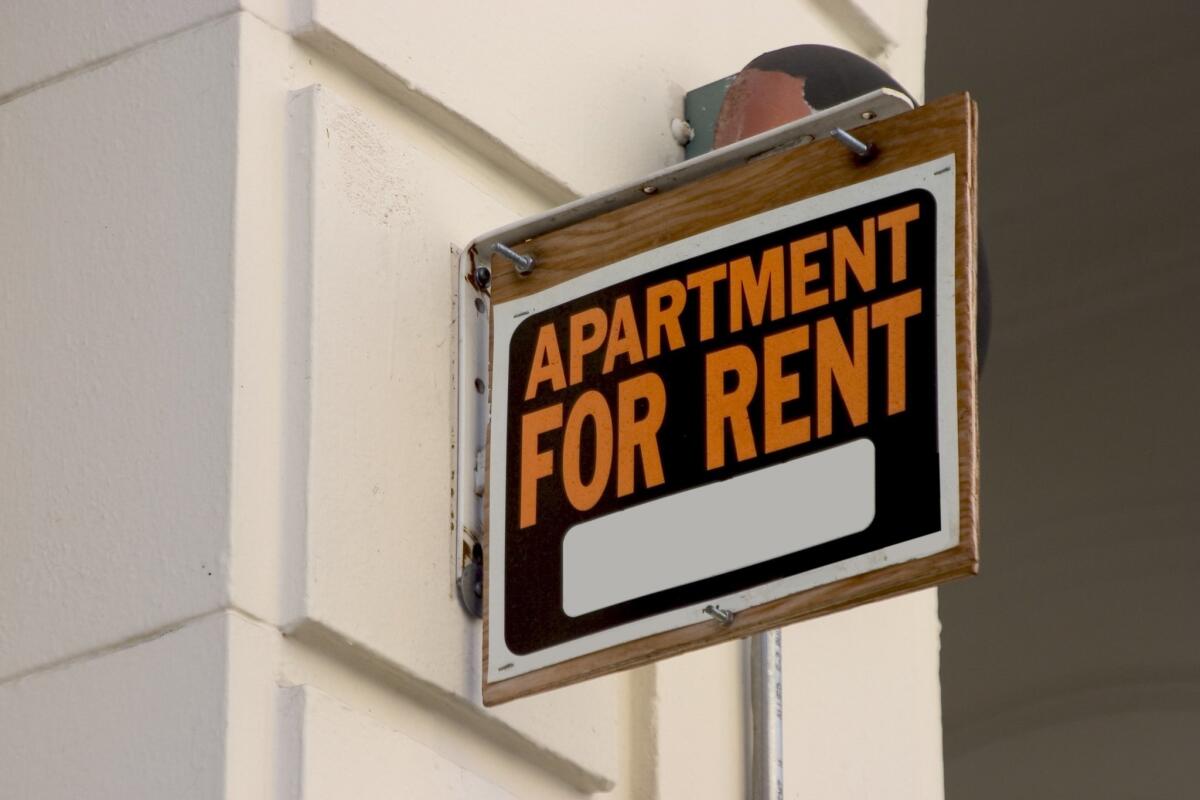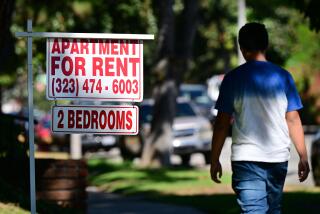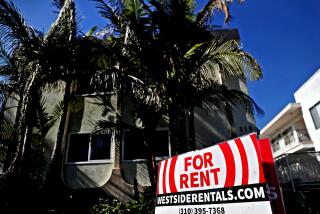Rent is falling in Los Angeles. Head east, you’ll find the opposite

In Los Angeles, apartment rent is on the decline amid the COVID-19 pandemic.
Estimated rent for a vacant apartment has fallen 5.3% since the beginning of the year in Los Angeles County, according to one measure, as landlords try to fill vacant units in a down economy.
In the Inland Empire, apartment hunters are encountering a stark difference.
“It’s day and night,” said Rafael De Anda, a CoStar Group Inc. analyst who specializes in the Inland Empire.
In Riverside County, rent for vacant units jumped 6.9% between January and October, according to rental website and data provider Apartment List, which produces a monthly rent index based on listings on its website. In San Bernardino County, rent soared 9.1%.
Apartment List, which supplied the Los Angeles data, said the pattern between urban and suburban areas is repeating in many places across the country.
The stark divergence reflects how people are responding to the pandemic, experts said.
Although solid data on recent migration patterns isn’t yet available, anecdotal evidence points to some people leaving big city apartments for more space while they work from home.
Real estate agents say those who can afford it are buying houses in Los Angeles and surrounding areas, driving up home prices. But others are moving from the coast to roomier Inland Empire rentals to handle their Zoom calls, De Anda said, citing conversations with property managers.
Lewis Management Corp. is one of the largest landlords in the Inland Empire, with more than 6,000 units in total. Randall Lewis, executive vice president, said a growing share of the company’s new tenants are coming from more expensive Los Angeles and Orange counties.
“It was really when people recognized ‘I may be working from home for more than a month or two,’” he said.
Rob Warnock, a research associate with Apartment List, said that for some movers the decision is probably more about money than space: as they’ve taken a hit financially in the downturn, they’ve ventured east for cheaper housing.
But he said he believes the key reason for the diverging rent trends is that fewer renters are relocating to big cities rather than that people are leaving those cities for surrounding areas.
Not only have companies cut jobs, but when they do hire, it’s increasingly likely employers don’t mandate workers come into the office.
Universities are also holding online classes to stop the spread.
“Places like L.A., really any big city that has a lot of economic drive, every summer we get people who move into these cities for college or people changing careers,” Warnock said. “It’s not so much that people are moving from L.A. to Rancho Cucamonga, but rather the people who were planning to move to L.A. are thinking, ‘Do I really need to move to L.A.,‘” or can they move to the suburbs?
Warnock said their ultimate destination might now be the Inland Empire or even more suburban L.A. County cities.
For example, a recent Apartment List analysis found the urban-suburban divide is evident not just in places such as the Inland Empire that have long served as an affordable escape for coastal residents, but in individual metros as well, including the large metro of Los Angeles and Orange counties.
In the city of Los Angeles, rent fell 6% between January and September, but only 1% across other cities in L.A. and Orange counties, according to a recent analysis from Apartment List that used the most recent data available at the time.
In the city of Riverside, meanwhile, rent rose 2% between January and September, but across other Inland Empire cities was up 7%.
In 27 out of 30 large U.S. metro areas, the main city in the region saw larger rent declines or less rent growth during the pandemic than its suburbs, Apartment List found. In 11 of the metros, the company said rent is falling in the main city while climbing in the suburbs.
In the Inland Empire, rent is also rising faster than it was last year.
Helping drive the current increases is falling vacancy that gives landlords “the power to raise rents,” De Anda said.
In Los Angeles County, the percentage of vacant apartments rose from 4.79% in the fourth quarter to 6.14% last week, CoStar data show. But in the Inland Empire, vacancy has dropped from 5.3% to 3.8%.
“In apartment communities that have one or two units available, they are going to mark it up and see if anybody is willing to pay that price,” De Anda said.
That power extends to renewals as well. In September, data from another real estate firm, RealPage, show tenants renewing their leases saw an average increase of 2.7% in the Inland Empire, compared to essentially no change in L.A. and Orange counties.
Lewis said his company has been able to increase rent about 3% to 4% for renewals and vacant units as vacancies have declined at its middle and upper-middle class communities. He cited the increased demand from the coast, but also the local economy.
Although the inland region has shed jobs recently, it’s fared better than some places. That’s in part because Riverside and San Bernardino counties are hubs for the logistics, or goods movement, industry. Thanks to an increased desire to shop online, that sector has done better than marquee Los Angeles industries such as entertainment and tourism.
The unemployment rate is 12.1% in L.A. County, but 9% in the Inland Empire.
Rising rents stand to make housing even less affordable for many households.
In 2019, a time when the economy was far more robust, nearly 30% of Inland Empire renters spent more than half their gross income on housing, according to Harvard University’s Joint Center for Housing Studies.
Nathan Cieszynski, program manager with the Fair Housing Council of Riverside County, said he’s increasingly fielding calls from panicked tenants facing rent increases. In some cases, he said the landlord is trying to raise rent beyond the legal limit imposed by the state’s rent cap law, which limits annual rent increases in buildings more than 15 years old to 5% plus inflation.
“We deal with the low- to moderate-income population — any rent increase is a big deal,” Cieszynski said. “They don’t know where else they can go.”
Overall, CoStar data show the largest rent increases have come in higher-end properties, where average rent for a vacant unit in the Inland Empire has grown 9.3% over the last year, compared with the previous four-year average of 3.8%.
In older, more rundown properties where lower-income households are likely to live, rent is up 3.4%, compared with the previous four-year average of 4.9%.
De Anda said the higher rent grown in newer, more luxurious buildings indicate most of the additional demand in the Inland Empire has come from people with decent jobs seeking more space for less money rather than those in financial distress looking for the lowest price possible.
How long the suburban-urban rental divide continues will probably depend on how long the desire for suburban living continues, Warnock said.
In recent earnings calls, some publicly traded apartment companies that own tens of thousands of units nationwide said they aren’t bracing for a quick reversal.
“We haven’t seen anything that leads us to believe that the trends ... are likely to change meaningfully in the near term,” Michael Manelis, chief operating officer of Chicago-based Equity Residential, told analysts last month. “The suburban portfolio should continue to outperform.”







